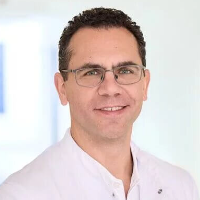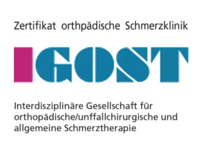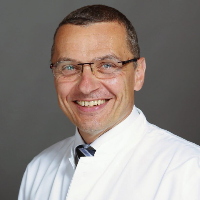Hip Dysplasia — Hip Replacement: treatment in the Best Hospitals of Germany
Treatment prices are regulated by national law of the corresponding countries, but can also include additional hospital coefficients. In order to receive the individual cost calculation, please send us the request and medical records.

Department of Adult and Pediatric Orthopedics, Traumatology
The Department of Adult and Pediatric Orthopedics, Traumatology is part of the specialized Center for Musculoskeletal Disorders, whose medical team consists of highly qualified orthopedists, traumatologists, and spinal surgeons. The department offers modern diagnostics and treatment of the entire range of musculoskeletal diseases. The department's field of competence includes the treatment of injuries of varying severity. The therapeutic options cover both conservative measures and surgical interventions, which are mainly performed using sparing minimally invasive techniques. The treatment concept is based on the comprehensive approach – from the use of conservative methods to physiotherapeutic procedures the day after surgery.






Department of Adult and Pediatric Orthopedics, Traumatology, Foot Surgery
According to the prestigious Focus magazine, the Department of Adult and Pediatric Orthopedics, Traumatology, Foot Surgery ranks among the top German medical facilities specializing in hip surgery! The department offers the full range of high-precision diagnostics and conservative and surgical treatment for diseases of bones, joints, muscles, ligaments, and tendons. One of the department's key areas of clinical practice is large joint arthroplasty. In this area, the department is awarded the prestigious endoCert certificate. The doctors in the department's operating rooms successfully perform knee, hip, and shoulder replacement surgery. Whenever possible, preference is given to minimally invasive joint replacement surgery. An important part of the work of the department's doctors is the treatment of orthopedic diseases and musculoskeletal injuries in children. The specialists at the medical facility also have long experience in helping patients with foot pathologies and deformities, including hallux valgus, hallux rigidus, hammer toes and claw toes, metatarsalgia, etc. The department's doctors have in their arsenal state-of-the-art equipment and modern treatment methods that allow for the achievement of excellent therapeutic results. More than 3,500 inpatients and about 17,000 outpatients are treated at the medical facility every year.




Department of Orthopedics, Traumatology, Spinal Surgery and Foot Surgery
According to the Focus magazine, the Department of Orthopedics, Traumatology, Spinal Surgery and Foot Surgery ranks among the top German medical facilities in treating orthopedic diseases and spinal surgery! The department carries out comprehensive examinations and effectively treats musculoskeletal diseases and injuries. The department has about 130 beds for its patient hospitalization. Doctors annually admit more than 4,000 patients for inpatient treatment. Several thousand surgical interventions of varying complexity are performed on the basis of the medical facility annually. The department offers the services of the certified Maximum Care Joint Replacement Surgery Center (EPZmax) and the certified Trauma Center. In addition, the department's specialists have vast experience in treating spinal and foot pathologies. The main goal of the department's doctors is to restore mobility and eliminate pain. The specialists always prefer an individual approach to each patient and his clinical case.






Hip dysplasia is accompanied by gradual degeneration of the hip joint. It wears out quickly, so many patients need replacement surgery. Joint damage that develops due to dysplasia is called dysplastic coxarthrosis. Its treatment is technically complicated and not always successful.
To get a good result and avoid the need for revision surgery, you can undergo treatment in one of the best German hospitals. Please use our service to choose the most suitable hospital and book a medical care program. On our website, you can compare the cost of treatment in different German hospitals and book a medical care program at an affordable price.
Content
- Why does hip dysplasia develop?
- Diagnostics
- Who may need hip replacement?
- What is the difficulty of hip replacement?
- Why do doctors in Germany perform successful surgery even for dysplasia?
- How is the surgery performed?
- Why is it worth undergoing treatment in Germany?
- Treatment in Germany with Booking Health
Why does hip dysplasia develop?
Dysplasia is a congenital underdevelopment of the joint. It is dangerous because it leads to hip dislocation. One limb becomes shorter than the other. The patient suffers from severe pain and lameness. The joint wears out gradually, and dysplastic coxarthrosis develops at a young age. When it reaches grade 3-4, the patient needs replacement surgery. It is dysplasia that is the most common cause of hip replacement in people under the age of 50.
The following risk factors can cause the development of the pathology:
- Genetic predisposition increases the risk of the disease by 10 times as compared to people who do not have this disease in their family history.
- Female sex – dysplasia affects women 3 times more often.
- Breech presentation, large fetus, oligohydramnios, gynecological diseases in the mother.
- Influence of toxic factors in the first half of pregnancy.
The most unfavorable type of the disease is teratogenic hip dislocation. It occurs even in utero. Doctors do not even try to treat such clinical cases with conservative methods, but immediately resort to a surgical intervention.
Dysplasia is a common condition. It occurs in 4-5% of the population. About half of them will be diagnosed with coxarthrosis during their lifetime. However, not every case of pathology will require hip replacement surgery. In many people, the disease does not cause any symptoms and is not diagnosed during life. If coxarthrosis develops, then this can occur in old age, and the pathology does not always reach grade 3-4. Only one in ten patients with dysplasia will have a dislocated hip. Moreover, most of these cases are treated with conservative methods, and only in a small number of cases surgical interventions are required.
Cost of total hip replacement for hip dysplasia is from €11,783. You can find prices for other treatment options on the Booking Health website.
The best hospitals in for the treatment of hip dysplasia Germany are:
- University Hospital Rechts der Isar Munich
- University Hospital of Ludwig Maximilian University of Munich
- University Hospital Ulm
- University Hospital Frankfurt-am-Main
- Vitos Orthopedic Clinic Kassel
Diagnostics
Doctors can detect hip dislocation and subluxation even during the clinical examination, but in the future, the diagnosis will be confirmed and clarified with the help of instrumental tests. Congenital hip dislocation is usually diagnosed in the maternity hospital.
The main methods of instrumental diagnostics are:
- X-ray scanning.
- Ultrasound scanning.
- CT scanning.
German hospitals have state-of-the-art diagnostic equipment. Physicians can obtain detailed layered images of the joint, create a 3D digital model, and plan surgical treatment perfectly.
Who may need hip replacement?
Not all patients require a total hip replacement for hip dysplasia. In most cases, the treatment involves the use of conservative methods. It begins immediately after the detection of pathology, even in childhood.
The disease has the following degrees of severity:
- Hip pre-dislocation (dysplasia).
- Hip subluxation.
- Hip dislocation.
Dislocation is the most severe pathology and requires reduction. Dislocation accounts for only 10% of cases of dysplasia.
Closed single-stage reduction of dislocation is no longer used. In the twentieth century, the doctors set the hip and applied a plaster cast to immobilize the limb. As of today, they apply the method of gradual reduction using a functional splint. This is preceded by the preparation within 2-3 weeks in order to eliminate muscle contracture.
Hip reduction is successful in most patients. However, if there is no result in the first 6 months, doctors have to resort to open surgery.
With hip dysplasia, the joint wears out much faster. In addition, shortening of the limb, lameness, and constant pain become a problem for patients. The knee and ankle joint on the affected side, as well as the knee joint on the other leg, are often deformed. The spine also suffers. Many patients undergo revision reconstructive surgery during their life. They usually do not completely cure hip dysplasia, but they can delay hip replacement as much as possible.
Total hip replacement is an extreme treatment, which can be used when other methods are ineffective. Surgery is usually performed for dysplastic coxarthrosis – joint destruction.
Even the highest quality endoprostheses wear out over time. Since hip dysplasia leads to the development of coxarthrosis at a young age, it is highly likely that the second hip replacement will be required in the future. For this reason, the doctors try to treat the disease as long as possible using other methods, without resorting to replacement surgery. However, sooner or later, the joint is completely destroyed, the patient's quality of life deteriorates significantly, so it is necessary to implant an artificial endoprosthesis instead of the patient's own joint.
What is the difficulty of hip replacement?
Hip replacement surgery for coxarthrosis is very common, and, in the vast majority of cases, it is successful. Its efficiency is on average about 90%, and in the best German hospitals – up to 98%.
The outcomes for hip dysplasia are worse. Poor functional results or chronic pain are twice as common. The operation is technically more complex, requires special knowledge and years of honed skills from the doctor.
Here are the main anatomical disorders that may develop in hip dysplasia and make the surgery complicated:
- Femoral head is displaced upward by a few centimeters.
- Flattening and atrophy of the acetabulum – the area of the pelvic bone, into which the femoral head enters, forming the hip joint.
- Rotation of the acetabulum and femoral neck.
- Deformed and narrow femoral canal.
- Atrophied hip muscles: abductors, quadriceps, back of the hip.
- Changed location of the sciatic nerve and deep femoral vein, which increases the risk of damage to these anatomical structures.
Surgery for hip dysplasia is not only less successful, but also more dangerous for the patient's health. These patients are more likely to have infectious complications, injuries to the large nerves and vessels, and increased blood loss. Early loosening of the endoprosthesis, hip dislocation, improper fusion or non-union of the bone tissue are possible after surgery. Many people need the second operation as early as the first year after the first replacement.
Even after successful surgery, chronic pain of a neurological origin may persist. In some patients, muscle strength cannot be restored.
Why do doctors in Germany perform successful surgery even for dysplasia?
German surgeons achieve good results in most patients, even for hip dysplasia. They use special techniques of replacement surgery to compensate for all defects in bone tissue and muscles. They use the very latest types of prostheses, and, if required, the prostheses are made individually using a 3D printer.
German orthopedists perform femoral shortening osteotomies, move the greater trochanter, perform bone grafting, use bone cement and reinforcing rings. Whenever required, replacement can be supplemented with osteosynthesis. Although the duration of treatment in this case increases, doctors manage to restore the normal length of the limb, even if it is shortened by more than 4-5 cm.
In most cases, patients have only one joint affected, but in 20% of cases, both hip joints are affected at once. Coxarthrosis can affect both joints, which requires bilateral hip replacement. In Germany, such operations can be performed both in one and in two stages. Some orthopedic centers perform single-stage bilateral replacement surgery, which means that both hip joints are replaced within a single surgical procedure. In addition, the knee joint on the affected side collapses over time in many patients. If necessary, German doctors can replace both hip and knee joints.
How is the surgery performed?
The doctor makes a 10-12 cm incision in the hip. He removes the patient's own joint, and artificial components of the endoprosthesis are implanted instead.
For dysplastic coxarthrosis, total hip replacement is performed. This means that two components of the artificial joint are implanted: the femoral and the pelvic (acetabular) ones. The endoprosthesis consists of a leg, a neck, a head, a cup and a liner. It provides perfect gliding with almost no resistance, so in the case of muscle recovery, it can provide good joint mobility.
After the surgery, a long-term recovery is required. It takes several months. Early rehabilitation takes place within 2-3 weeks. At this time, the person is in the hospital. The further recovery takes place in a rehabilitation center. Full load on the operated leg is possible after 2 months, and complete restoration of bone tissue and its mineralization occurs within 3-4 months.
Why is it worth undergoing treatment in Germany?
Hip replacement surgery for dysplasia is considered technically complex. It is important that they are performed by the best doctors in well-equipped hospitals. The treatment in Germany has the following benefits:
- Reliable results: the risk of early aseptic loosening of the endoprosthesis in the best German hospitals does not exceed 1%.
- Implanted endoprostheses serve for decades, which is especially important for patients with dysplasia, since most of them are young people under 50 years old.
- Successful treatment at any age: including children and patients over 90 years old.
- Some hospitals use fast-track rehabilitation protocols. They reduce the patient's hospital stay, improve functional outcomes, and reduce the risk of complications.
- It is possible to perform even the most complex operations, including in the case of significantly deformed acetabulum, revision (repeated) replacement surgery.
- Affordable cost of treatment. The treatment is cheaper in Germany than in most other developed countries. Prices here are one and a half times lower than in the USA and Japan.
In German hospitals, the patients andergo treatment in comfortable conditions. After the operation, they receive high quality care, symptomatic and analgesic treatment.
Treatment in Germany with Booking Health
To undergo hip replacement surgery in one of the best German hospitals, please use the services of Booking Health. On our website, you can see the cost of treatment in different German hospitals, compare prices and book a medical care program at an affordable price.
Please contact the specialists in Booking Health to undergo treatment in Germany. We will provide you with the following benefits:
- We will choose the best hospital whose doctors specialize in the treatment of hip dysplasia.
- We will help you overcome the language barrier, establish communication with the German hospital and your attending physician.
- We will reduce the waiting time for the medical care program and book an appointment with the attending physician on the most convenient date for you.
- We will reduce the price. The cost of treatment in Germany will be decreased due to the lack of additional coefficients for foreign patients.
- We will take care of all organizational issues: documents for entering the country, transfer from the airport, hotel, interpreter, etc.
- We will prepare a medical care program and translate medical documents into German. You do not have to undergo previously performed diagnostic procedures.
- We will provide communication with the hospital upon the completion of treatment in Germany.
- We will organize additional medical examinations, treatment in Germany or rehabilitation, if necessary.
- We will buy medicines in Germany and forward them to your native country.
- We will help you keep in touch with the hospital after treatment in Germany.
Booking Health makes treatment in Germany easier, faster and cheaper. We will fully organize your trip, and you will only have to focus on restoring your health.
Authors: Dr. Nadezhda Ivanisova, Dr. Sergey Pashchenko

